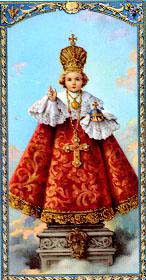
Memorial: 3rd Sunday May
Profile The popularity of the Child Jesus grew in Baroque Spain, possibly caused by the visions of Saint Teresa of Avila. Several Spanish sculptures found their way to Prague; they were made of wax, ivory, and bronze, and dressed in garments reflecting the aristocratic fashion of the period. The exact origin of the Infant Jesus statue is not known, but historical sources point to a 28cm high sculpture of the Holy Child with a bird in his right hand carved c.1340, but other sculptures were also carved by masters throughout Europe in the Middle Ages.
The well-known statue probably came from a monastery in Bohemia, obtained by Dona Isabella Manrique who gave it to her daughter Marie Manrique as a wedding gift, then to Marie's daughter Polyxena as a wedding gift in 1587. In 1628, Lady Polyxena presented the statue to the Carmelites at the Church of the Virgin Mary the Victorious. This statue became known as the Infant Jesus of Prague. It stands 47cm high, with a 2cm base, and has a long gown around the wax body.
Veneration ceased after 1628 when the Carmelites fled Prague ahead of invading Saxons and Swedes. In 1638 a young priest named Cyrillus a Matre Dei returned to Prague and found the statue in the ruins of the church. He cleaned the statue, and placed it in the oratory. While praying before it, he heard the Infant Jesus say, Have pity on Me and I will have pity on you. Give Me My hands and I will give you peace. The more you honor Me, the more I will bless you.
Repairing the statue's hand was a miracle as Father Cyril and his peers had neither the skills to do it themselves, not the funds to hire it done. Father Cyril asked that Our Lady to provide funds. The Divine Infant spoke again, saying Place Me near the entrance of the sacristy and you will receive aid. Cyril did as he was told, and a few days later the statue was fixed by a man who came by the sacristy.
With the statue repaired, miracles began to be reported, resulting in an increased veneration of the Holy Child. An altar was built for the image in 1641, and the gold and bejewelled crown on the statue was presented by Bernard Ignatius on 14 January 1651. In 1654 a chapel was completed to house it, and the Infant Jesus was coronated on 4 April 1655 by Archbishop Josef Corta.
Though Prague suffered through wars and unrest, the church and the Infant Jesus chapel were miraculously protected. The altar was rebuilt in 1776 using marble and two huge sculptures of the Blessed Virgin Mary and Saint Joseph. The Infant was kept in a glass case standing on a pedestal engraved with crystals, and surrounding the Infant were twenty angels in gold. Since then copies have been distributed throughout Europe, the Philippines, and the Americas, and devotion has continued to spread.
Devotion to this image is actually devotion to the Child Jesus. It is not idolatry, statue-worship, or any other slander. This is just a popular image, a way to visualize Christ, and bring a concrete form to someone who, for many people, needs to be visualized to be addressed.
Patronage children, colleges, family life, foreign missions, freedom, good finances, health, peace, schools, travellers, universities, vocations